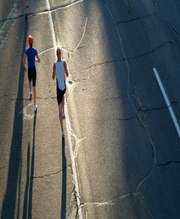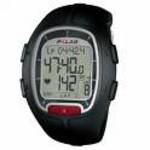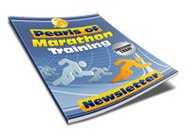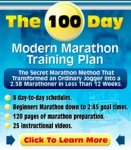I am Ready to Go..But How do I Marathon Pace Myself ?
"Marathon Pace Strategies Revealed"
 Marathon pace strategies/marathon pacing is one common question from marathon runners, especially from marathon rookies, first-time-runners; Marathon pace strategies/marathon pacing is one common question from marathon runners, especially from marathon rookies, first-time-runners;
"How fast do you I think I can run the marathon, what pace strategy should I use and how do I calculate this ?"
Sounds familiar?
A common answer you receive from the more experienced runner is : "umm, well, it is not a smart idea to go out too fast"
Not Too Fast in the Beginning of the Marathon , But How Fast is That ?
Of course, this is correct. You should not go out too fast. But..
Now then, how fast is actually not too fast for you ?
Better said than done.
Would not it be better if you could predict, beforehand, more exactly how fast you could actually run ?
Well, it may not be as hard as you think.
Let me explain.
The Basic Demands of the Marathon Related to Marathon Pace.
The physiological - that is the physical demands of the marathon, is well known.
The scientists have figured most of that out a long time ago. In the labs and by measuring marathon runners on all levels.
So what have they found out ?
And more important :
How can you apply this to predict your marathon time. To pace yourself through a marathon ?
What the Guys in the Labs Have Found Out is As Follows :
#1 The marathon is run slightly below your anaerobic treshold.
The anaerobic treshold is a big term for something as simple as this : it is the speed you can run at without accumulating lactate acid in your legs.
Or even better ;
"Just how fast, your limit, to where you can continue to run for a long time without gradually fading"
It is sort of a tipping point pace.
- You run right on your edge but not over.
- You should know this edge and respect it.
- Your marathon pace should be at a pace slightly below this.
It is optimal.
So.....How do You Find How Fast This Anaerobic Thresold is?
Well, there are three main ways to find this.
They are all very easy to use,
- The heart rate test
- The half marathon as prediction
- The 10k as a prediction
  Your Heart rate On a Simple Test. Your Heart rate On a Simple Test.
The general idea is to find your maximum heart rate (see the heart rate training article on this topic) then deduct 30 beats from this and run at that pace for 30 minutes.
The time you can run, with an average of 30 beats below max HR for 30 minutes, is your approxiate marathon time at the moment.
Which will be a good starting pace for a marathon. And if you really have the perfect day during the marathon, you can do harder after 30-32 k (20 miles)
Or you can use the half marathon as a prediction :
 Half Marathon Time For a Prediction. Add 5 % To It ! Half Marathon Time For a Prediction. Add 5 % To It !
You may use a conversion table to predict your anaerobic threshold and marathon time from the half marathon or simply take your half marathon time and add about 5 % to it.
This is especially good if you are currently on a half marathon training schedule.
 You Can Even Use Your 10 Km Time. You Can Even Use Your 10 Km Time.
If you have run one and add 10 % to that time.
This is very general, of course,but actually a pretty good guideline.
Based on this you will find the pace you are physically capable of running the marathon in.
I am working on making some specific "calculators" to find this exactly for you. But not finished yet with them.
This is Sort of Your Potensial. Then You Have..... Nutrition,Muscular Demand and the Weather.
These three factors :
- the nutrition,
- the muscular demands,
- and the weather
Also needs to be taken care of. To bring out your calculated potensial. These are sort of the outside factors. That together with your calculated time will determined exactly how fast you will run - what marathon pace that will give you the best possible time.
Always take this into account !
First off, to get your goal time, your potensial, you also need to meet challenge of marathon nutrition. Read more about marathon nutrition here.
Point is.
If the engine runs out of pure gas, it does not matter how powerful and fine-tuned the engine is.
Second, the marathon is a muscular challenge for the legs.
This is the cramps, beating of the legs etc. that often occurs in the marathon if you are not well enough prepared.
A good marathon training schedule respects this. Incorporates it. And prepares the athlete for it. With some long,steady runs on hard surface. At least three times. About 30,20 and 10 days before the race respectivly.
In Addition You Have the External Factors. To Influence the Marathon Pace.
 Like running in the heat, wind or cold (taking into consideration that they even have a marathon on the South Pole now :) Like running in the heat, wind or cold (taking into consideration that they even have a marathon on the South Pole now :)
 Always take the external factors into consideration. Respect the weather and learn to deal with it. Always take the external factors into consideration. Respect the weather and learn to deal with it.
I will write some more about how to deal with the weather later.
But until then :
To sum it up..
The Point to All of This ?
" Find your marathon pace by the heart rate test/half marathon time or 10 km time. Then optimize the marathon nutrition and practice dealing with the hard surface the marathon is run at. "
Before pacing your marathon on the optimal marathon pace you have found.
Thanks for your attention and good luck with your marathon pace strategy.
More articles below
|
 Enter email address to subscribe for monthly updates and tips. I will not spam your account, only occasional relevant information :)
Enter email address to subscribe for monthly updates and tips. I will not spam your account, only occasional relevant information :)

 Marathon pace strategies/marathon pacing is one common question from marathon runners, especially from marathon rookies, first-time-runners;
Marathon pace strategies/marathon pacing is one common question from marathon runners, especially from marathon rookies, first-time-runners; 
 Like running in the heat, wind or cold (taking into consideration that they even have a marathon on the South Pole now :)
Like running in the heat, wind or cold (taking into consideration that they even have a marathon on the South Pole now :)